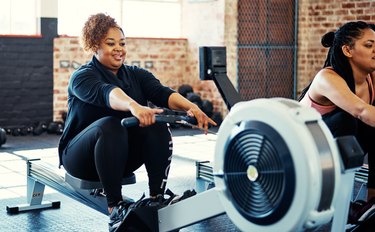
If your experience with a rowing machine is limited to skirting around one on your way to the treadmill or elliptical, you may want to reconsider the detour and give the rower a chance. It combines a low-impact, heart-pumping cardio workout with full-body strength.
Not only is it fairly easy to pick up the basics, it also activates muscles from head to toe —- at least 65-percent lower-body work and up to 35-percent upper-body work, according to the American Fitness Professionals Association.
Video of the Day
"Rowing engages the majority of your muscles, particularly the back, glutes, hamstrings and core," says Nick Karwoski, a top-ranked US triathlete and the founder of Tagalong, a personalized one-on-one training and coaching program.
So if you're willing to give it a try, follow along with Karwoski's basic rowing stroke tutorial below, then use what you've learned to complete the 20-minute beginner's rowing workout he created.
How to Use a Rowing Machine
- Sitting tall with your arms extended, begin each stroke by pressing down on the balls of your feet and pulling power from your hips.
- As you straighten your legs, lean your upper body back and pull your hands to your chest, pulling your shoulder blades together, to complete the stroke.
- Then, reverse the process (this is called the recovery phase) by returning to the starting position.
Tip
A useful way to remember the proper sequence is "legs, body, arms" for the drive and "arms, body, legs" for the recovery.
And while getting the basics down is fairly straightforward, perfecting the stroke takes practice. Karwoski recommends beginners row alongside a coach or seasoned rower at first, either in person or in front of a video screen, to help you adjust your form.
Try This Beginner Rowing Workout
Karwoski designed the following 20-minute rowing workout for those who've never even sat on a rowing machine before. The warm-up especially will help you perfect your stroke. Then, once you're comfortable with the basics, you can progress to Option 2.
Warm-Up
You'll begin with a 3-minute (or 500-meter, as it's measured on most machines) warm-up, starting with muscle isolation to warm up your entire body.
- Begin sitting tall with your legs straight.
- Without moving your lower body or torso, perform arm-only strokes for 30 seconds, focusing on a smooth transition from pulling the handlebar in toward your body and back to the starting position.
- Add your core to the sequence by leaning forward when your arms are straight out in front of you and leaning back as you bring the handlebar to your chest.
- Gradually introduce the legs into the stroke, first with a "half-slide" and then a "full-slide."
- Spend the remaining time at the full slide, doing 10 strokes at 20 strokes per minute (s/m) to 26 s/m.
- Take a 3- to 5-minute break to stretch your hamstrings, glutes, quads, calves and lower back.
Tip
If you're already familiar with the rowing stroke and have decent form, you can skip the detailed warm-up and perform a basic, low-rhythm warm-up.
Workout
Option 1: Alternate between 1-minute intervals of work and 1 minute of rest for 6 rounds. Increase your strokes per minute each time.
Option 2: Perform 4 four-minute intervals of work with one minute of rest in between each one.
- Row at a lower rhythm for 3:30 minutes, then add a burst of speed for 30 seconds at the end (4 minutes of work total).
- Rest for one minute. This can be a recovery minute of easy, low-effort rowing or a full rest where you stop, get off the machine and slowly move or walk around (to encourage continued blood flow).
- For each of the next 3 sets, keep to the low rhythm row for the first 3:30. Then, for the burst, try to increase your power and improve your 30-second split each time.
Cooldown
Whichever option you choose, it's essential to finish with stretching and/or foam rolling your lower back, glutes, hamstrings and calves, as these are the primary muscle groups working during a rowing workout.